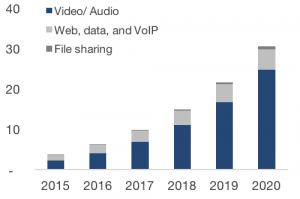INTRODUCTION
Having been the instrument for raising billions of dollars in 2017, ICOs have captured the imagination of Silicon Valley and Wall Street alike. Yet much of the discussion around their actual implementation still remains abstract. The whitepapers put forth in connection with ICOs often contain many clichés claiming to decentralize a certain market or undermine the control of existing middlemen.
But the potential of blockchain and cryptocurrencies to change markets is more nuanced and far-reaching than that simple narrative. In an effort to move beyond speculations to reality, we have decided to explore a range of specific real-world applications across a selection of markets and industries. As the start of this series of papers, we present an explorative look into the digital content industry, with content stream platforms such as Spotify and Youtube being the focus.
WHAT IS THE OPPORTUNITY?
Online media consumption has shown tremendous growth over the past few years. In particular, we see the following trends:
- Increase in number of mobile devices – the number of smartphones crossed the 2 billion mark in 2014, and is growing at a CAGR of 17%. The total number of smartphones will be nearly 50% of global devices and connections by 2020. It is easier then ever before for consumers to access music and video content on the go.
[vc_empty_space height=”10px”]
- Better network coverage – in 2015, smartphone mobile data traffic alone stood at 2.8 EB per month, which is expected to grow and cross four-fifths of total mobile data traffic by 2020. The internet has been and will continue to be a disruptive force impacting distribution and consumption channels for media.

- Video and audio traffic dominates internet data consumption – global audio and video traffic combined is expected to reach 82% of all internet traffic by the end of 2018. Netflix, over-the-top service providers like YouTube, and subscription-based digital content providers like Spotify have acted as catalysts in the growth of audio/video data streaming.
WHAT ARE THE PAINPOINTS?
Content streaming providers like Spotify earn a majority of their revenue from either subscriptions or advertising. At the end of the month they need to decide how much and with whom they share their revenue. Thus, they keep track of their user’s playing history.
This seemingly simple process is actually much more complicated than it may seem at first:
- Multiple parties claiming rights – there could be over 10 parties claiming rights to a song – the record company, the singer’s association, the song writers, and other performing rights organizations. Yet there is no universal standard or database for reference.
- Long payout process – the cheques only make their way to the artists after passing through all the intermediaries such as the labels, payment service providers, and channel partners, each of whom has its own accounting processes, timelines, fee structures, and reporting standards.
- Micropayment never get paid – the transaction cost involved for a $10 payout can amount to $5. Naturally streaming platforms have a minimum payout threshold, which may not be encouraging for some emerging artists.
Although the digital content industry is already on a steep growth trajectory – in terms of both adoption and revenue – we see an opportunity for blockchain to increase the diversity, quality, and effectiveness of the transaction process. In particular, the payout problem remains a significant challenge to industry players and is an area where we see potential for blockchain to provide real value.
HOW DOES BLOCKCHAIN HELP?
A way of doing so is to establish a content protocol on blockchain, where the metadata of content can be standardized and stored in smart contracts.
Artists upload their content to this network, where a fingerprint for each piece of content can be created and stored in a smart contract. The ownership of that piece of content, i.e. the unique address of the artist, will also be recorded in the same smart contract.

In doing so, it allows for a number of applications that were not possible with the legacy financial infrastructure:
- Multi-party payment – every time when a piece of content is accessed, the smart contracts connected to the content’s address would recognize the source of the access (whether it is from Spotify or from Youtube), and then instantly split and redirect the income received to all the addresses entitled to payments.
- Single source of IP right registrations – metadata of intellectual properties become standardized and can be stored in smart contracts. While this was technologically possible before blockchain, commercialization from a single source of content makes it financially realistic in the blockchain era.
- Mini-crowdfunding for digital content – the transferring and trading of IP rights will become much easier. It enables a secondary market for content rights to flourish. Smart contracts allow automatic and instantaneous payment to relevant right holders. Investment in these intellectual property rights can therefore be done in small amounts, and be accessible and affordable to common people.
CONCLUSION
At Standard Kepler we believe the essence of the blockchain technology’s ability to transform markets lies in transaction cost saving. It reduces labor-intensive accounting processes and eliminates duplicate effort, with multiparty payments being the case in point as illustrated above. We look forward to exploring more actual implementations of the technology in upcoming issues, and observe how it brings about real changes beyond the realms of speculation.
© 2018 Standard Kepler




